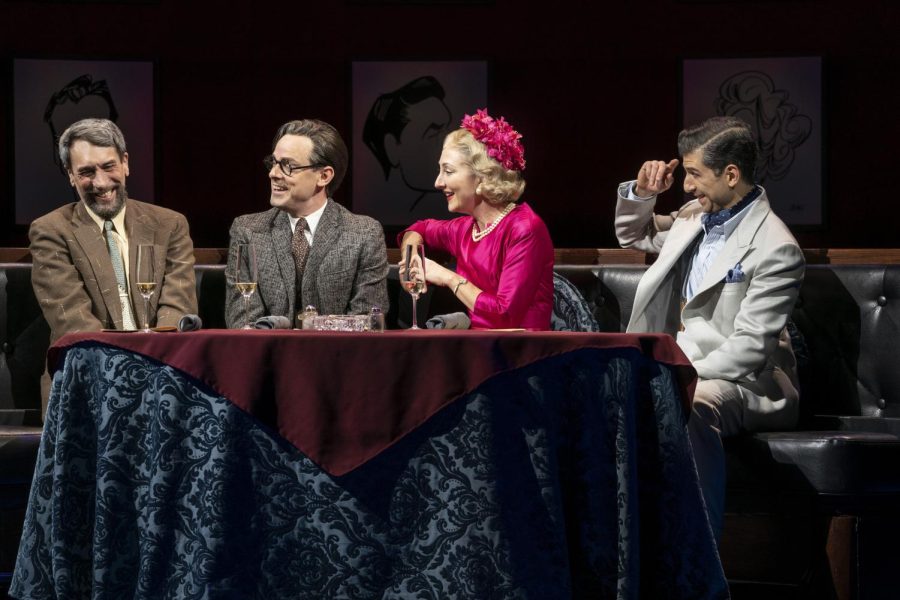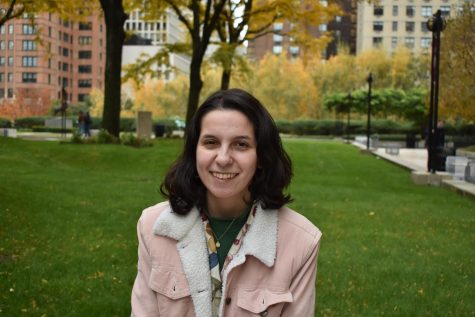‘Flying Over Sunset’ Is a Beautiful but Unsteady Trip
The new Lincoln Center Theater musical is ambitious but falls short of perfection
COURTESY OF JOAN MARCUS
Robert Sella, Harry Hadden-Paton, Carmen Cusack and Tony Yazbeck in “Flying Over Sunset.”
December 13, 2021
An audience member doesn’t need to seek out LSD to properly experience this new puzzling production about psychedelics playing across the street from campus at Lincoln Center’s Vivian Beaumont Theater.
Based on the first sneak peek of the show’s original soundtrack by Tom Kitt and Michael Korie, specifically the title song “Flying Over Sunset,” that was released pre-pandemic, I knew that this musical would be special compared to the film adaptations and jukebox musicals that currently populate Broadway.
From the brilliant mind of James Lapine, “Flying Over Sunset” is the brainchild that he wrote and directed. With all that creative freedom, Lapine, who is a frequent collaborator with Stephen Sondheim (“Into the Woods,” “Sunday in the Park with George”) and William Finn (“Falsettos,” “The 25th Annual Putnam County Spelling Bee”), certainly tries to pull off a lot.
The show is very stunning to behold, similar to older-style Broadway musicals.
Running at about 2 hours and 40 minutes and taking place in the 1950s, the new musical imagines writer Aldous Huxley, conservative congresswoman Clare Boothe Luce and film legend Cary Grant all meeting up together to take an LSD trip in order to make sense of the world and themselves. The first act closely follows the influential figures, who reportedly had a relationship with LSD, and how they got involved in the use of psychedelics for therapeutic purposes. On the other hand, Act 2 is entirely fictionalized with the imagined get-together.
The talent behind this production is obvious from the very top of the show. Lighting designer Bradley King, known for his work on “Hadestown” and “Natasha, Pierre & the Great Comet of 1812,” perfectly captures the spiritual and otherworldly effects of LSD that attempt to fill the emptiness in these figures’ lives. This, in combination with the projections handled by 59 Productions and sets by Beowulf Boritt, brings the mostly barren stage to life. The show is very stunning to behold, similar to older-style Broadway musicals.
That sentiment applies to the performers as well. Fourteen-year-old Atticus Ware as a young Cary Grant received the most applause of the night with the tap number “Funny Money” performed alongside Tony Yazbeck and choreographed by MacArthur “Genius Grant” winner Michelle Dorrance. The two actors bounce off one another so well to create an emotional performance that fully expresses the deep inner child work that Grant has cut out for him.
The Act 2 premise of a fictionalized LSD playdate ends up less inspired than expected as it mimics the structure of the previous act.
Just as I suspected from the sneak peek video, watching Carmen Cusack as Luce feels like watching history unfold in front of your eyes. Her character receives the meatiest backstory of the trio, and her vocals in the 11 o’clock number “How?” are unprecedented.
All the vocals in the show are gorgeous, but don’t be surprised if Cusack earns a Tony nomination for this role.
The Act 1 finale, the reprise of “Flying Over Sunset,” promises a lot for Act 2 as it quite literally shoots for the stars, but not all those promises are satisfied. The Act 2 premise of a fictionalized LSD playdate ends up less inspired than expected as it mimics the structure of the previous act.
Despite all gathering together, nearly the entire act has an individual character sing a song about their specific circumstances, while the others fade to the background or make a light comment or two. The only time multiple people engage with the same portion of a trip is during a sequence on a beach with Huxley (Harry Hadden-Paton), Grant and their guide Gerald Heard (Robert Sella).
Story-wise, the moments of interaction are the most exciting, yet they are far and few between.
There are more songs in Act 2 and fewer scene breaks, but everything tends to fade together into a lull. All the songs are sung and orchestrated well technically speaking, yet nothing stands out.
The story itself is in sync with this behavior. Outside individual traumas involving grief and identity, the musical tries to tackle a multitude of themes including, but not limited to, conservatism and homosexuality. Heard has to often remind our three characters, as well as the audience, that there’s no need for conversations concerning politics while tripping on LSD. Topics are touched on but not always completely explored.
While not without its flaws, the ambition and originality behind “Flying Over Sunset” is inspiring for all creatives out there.
There’s potential in leaving something to be desired, if treated tastefully. From a big picture standpoint, the plot is rather simple, and the ending shot focusing on the power of human embrace stays true to that. I think Lapine actually wants a very simple message to be conveyed here in this high-concept piece.
Even with the grandiose and downright magical aspects of these LSD-induced, hallucinated trips, a mere mortal can’t visit the afterlife, and the human mind can’t be conquered in a single day. No matter how hard you try, there will always be mysteries to uncover. The unknown never stops being unknown, and the self never stops changing. The best thing to do is to try and balance that internal work while also keeping in the moment and holding those you love close.
While not without its flaws, the ambition and originality behind “Flying Over Sunset” is inspiring for all creatives out there, even if it can leave you a little frustrated at times. No matter, I will continue humming the title tune just as I did throughout the Broadway lockdown because yes, it sounds that lovely.













